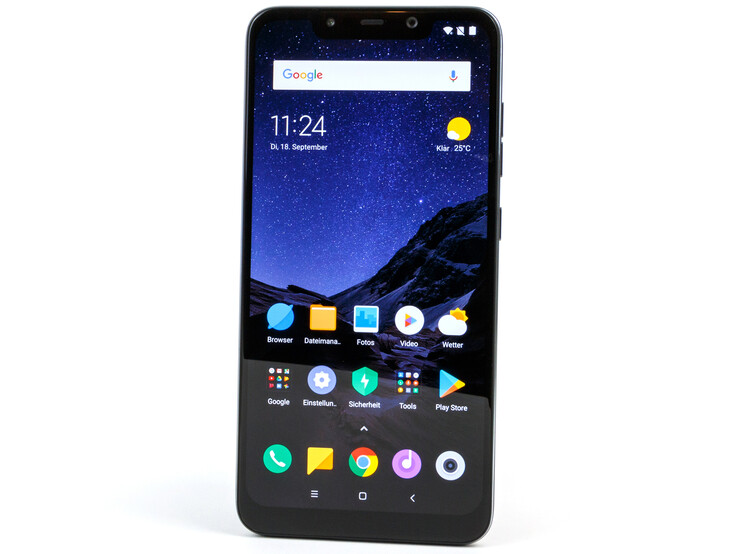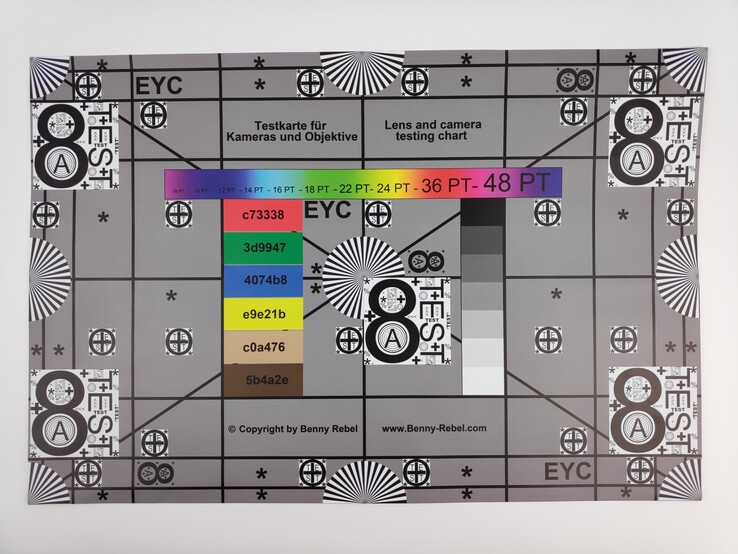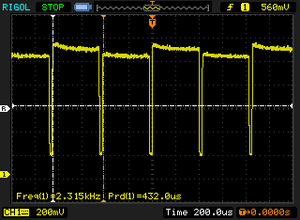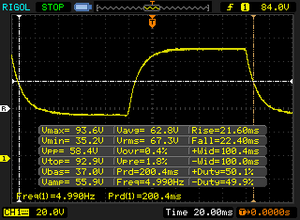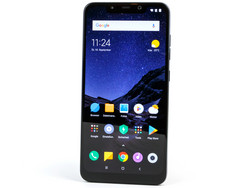Breve Análise do Smartphone Xiaomi Pocophone F1
Os Top 10
» Os Top 10 Portáteis Multimídia
» Os Top 10 Portáteis de Jogos
» Os Top 10 Portáteis Leves para Jogos
» Os Top 10 Portáteis Acessíveis de Escritório/Empresariais
» Os Top 10 Portáteis Premium de Escritório/Empresariais
» Os Top 10 dos Portáteis Workstation
» Os Top 10 Subportáteis
» Os Top 10 Ultrabooks
» Os Top 10 Conversíveis
» Os Top 10 Tablets
» Os Top 10 Smartphones
» A melhores Telas de Portáteis Analisadas Pela Notebookcheck
» Top 10 dos portáteis abaixo dos 500 Euros da Notebookcheck
» Top 10 dos Portáteis abaixo dos 300 Euros
Size Comparison
| Networking | |
| iperf3 transmit AX12 | |
| Sony Xperia XZ2 Premium | |
| Xiaomi Poco F1 | |
| OnePlus 6 | |
| Samsung Galaxy S9 Plus | |
| Honor 10 | |
| iperf3 receive AX12 | |
| Sony Xperia XZ2 Premium | |
| Xiaomi Poco F1 | |
| Samsung Galaxy S9 Plus | |
| OnePlus 6 | |
| Honor 10 | |
| |||||||||||||||||||||||||
iluminação: 93 %
iluminação com acumulador: 489 cd/m²
Contraste: 1438:1 (Preto: 0.34 cd/m²)
ΔE ColorChecker Calman: 3.8 | ∀{0.5-29.43 Ø4.78}
ΔE Greyscale Calman: 4.4 | ∀{0.09-98 Ø5}
99.5% sRGB (Calman 2D)
Gamma: 2.22
CCT: 7213 K
| Xiaomi Poco F1 IPS, 2246x1080, 6.2" | Honor 10 IPS, 2280x1080, 5.8" | OnePlus 6 Optic AMOLED, 2280x1080, 6.3" | Nokia 7 Plus IPS, 2160x1080, 6" | Samsung Galaxy S9 Plus Super AMOLED, 2960x1440, 6.2" | LG G7 ThinQ IPS, 3120x1440, 6.1" | |
|---|---|---|---|---|---|---|
| Screen | 9% | 15% | 7% | 27% | 7% | |
| Brightness middle (cd/m²) | 489 | 555 13% | 430 -12% | 458 -6% | 565 16% | 974 99% |
| Brightness (cd/m²) | 486 | 537 10% | 437 -10% | 463 -5% | 571 17% | 975 101% |
| Brightness Distribution (%) | 93 | 94 1% | 87 -6% | 92 -1% | 96 3% | 96 3% |
| Black Level * (cd/m²) | 0.34 | 0.39 -15% | 0.22 35% | 0.49 -44% | ||
| Contrast (:1) | 1438 | 1423 -1% | 2082 45% | 1988 38% | ||
| Colorchecker dE 2000 * | 3.8 | 2.3 39% | 2.3 39% | 4 -5% | 2.3 39% | 5.4 -42% |
| Colorchecker dE 2000 max. * | 7.1 | 6 15% | 4.6 35% | 7.4 -4% | 4.8 32% | 13.1 -85% |
| Greyscale dE 2000 * | 4.4 | 3.9 11% | 2.4 45% | 4.7 -7% | 1.9 57% | 5 -14% |
| Gamma | 2.22 99% | 2.19 100% | 2.28 96% | 2.19 100% | 2.16 102% | 2.31 95% |
| CCT | 7213 90% | 6212 105% | 6160 106% | 7425 88% | 6332 103% | 7480 87% |
* ... menor é melhor
Cintilação da tela / PWM (modulação por largura de pulso)
| Tela tremeluzindo/PWM detectado | 2315 Hz | ≤ 20 % configuração de brilho | |
A luz de fundo da tela pisca em 2315 Hz (pior caso, por exemplo, utilizando PWM) Cintilação detectada em uma configuração de brilho de 20 % e abaixo. Não deve haver cintilação ou PWM acima desta configuração de brilho. A frequência de 2315 Hz é bastante alta, então a maioria dos usuários sensíveis ao PWM não deve notar nenhuma oscilação. [pwm_comparison] Em comparação: 53 % de todos os dispositivos testados não usam PWM para escurecer a tela. Se PWM foi detectado, uma média de 8111 (mínimo: 5 - máximo: 343500) Hz foi medida. | |||
Exibir tempos de resposta
| ↔ Tempo de resposta preto para branco | ||
|---|---|---|
| 24 ms ... ascensão ↗ e queda ↘ combinadas | ↗ 9.2 ms ascensão | |
| ↘ 14.8 ms queda | ||
| A tela mostra boas taxas de resposta em nossos testes, mas pode ser muito lenta para jogadores competitivos. Em comparação, todos os dispositivos testados variam de 0.1 (mínimo) a 240 (máximo) ms. » 53 % de todos os dispositivos são melhores. Isso significa que o tempo de resposta medido é pior que a média de todos os dispositivos testados (20.2 ms). | ||
| ↔ Tempo de resposta 50% cinza a 80% cinza | ||
| 44 ms ... ascensão ↗ e queda ↘ combinadas | ↗ 21.6 ms ascensão | |
| ↘ 22.4 ms queda | ||
| A tela mostra taxas de resposta lentas em nossos testes e será insatisfatória para os jogadores. Em comparação, todos os dispositivos testados variam de 0.165 (mínimo) a 636 (máximo) ms. » 72 % de todos os dispositivos são melhores. Isso significa que o tempo de resposta medido é pior que a média de todos os dispositivos testados (31.6 ms). | ||
| Lightmark - 1920x1080 1080p (classificar por valor) | |
| Nokia 7 Plus | |
| Samsung Galaxy S9 Plus | |
| Huawei P20 Pro | |
| Basemark ES 3.1 / Metal - offscreen Overall Score (classificar por valor) | |
| OnePlus 6 | |
| Nokia 7 Plus | |
| LG G7 ThinQ | |
| Samsung Galaxy S9 Plus | |
| Huawei P20 Pro | |
| Média Qualcomm Snapdragon 845 (1169 - 1201, n=5) | |
| Média da turma Smartphone (205 - 7731, n=36, últimos 2 anos) | |
| JetStream 1.1 - Total Score | |
| LG G7 ThinQ (Chrome 66) | |
| OnePlus 6 (Chrome 66) | |
| Média Qualcomm Snapdragon 845 (22.5 - 90.9, n=25) | |
| Xiaomi Poco F1 (Chrome 68) | |
| Sony Xperia XZ2 Premium (Chrome 68) | |
| Samsung Galaxy S9 Plus (Samsung Browser 7.0) | |
| Huawei P20 Pro (Chrome 65) | |
| Honor 10 (Chrome 66) | |
| Nokia 7 Plus (Chrome 60) | |
| Octane V2 - Total Score | |
| Média da turma Smartphone (2228 - 121337, n=200, últimos 2 anos) | |
| OnePlus 6 (Chrome 66) | |
| LG G7 ThinQ (Chrome 66) | |
| Média Qualcomm Snapdragon 845 (3991 - 18275, n=28) | |
| Samsung Galaxy S9 Plus (Samsung Browser 7.0) | |
| Xiaomi Poco F1 (Chrome 68) | |
| Sony Xperia XZ2 Premium (Chrome 68) | |
| Huawei P20 Pro (Chrome 65) | |
| Honor 10 (Chrome 66) | |
| Nokia 7 Plus (Chrome 60) | |
| Mozilla Kraken 1.1 - Total | |
| Nokia 7 Plus (Chrome 60) | |
| Honor 10 (Chrome 66) | |
| Huawei P20 Pro (Chrome 65) | |
| Sony Xperia XZ2 Premium (Chrome 68) | |
| Média Qualcomm Snapdragon 845 (2154 - 11204, n=28) | |
| Xiaomi Poco F1 (Chrome 68) | |
| LG G7 ThinQ (Chrome 66) | |
| OnePlus 6 (Chrome 66) | |
| Samsung Galaxy S9 Plus (Samsung Browser 7.0) | |
| Média da turma Smartphone (257 - 28190, n=155, últimos 2 anos) | |
| WebXPRT 2015 - Overall | |
| OnePlus 6 (Chrome 66) | |
| LG G7 ThinQ (Chrome 66) | |
| Média Qualcomm Snapdragon 845 (96 - 291, n=23) | |
| Xiaomi Poco F1 (Chrome 68) | |
| Sony Xperia XZ2 Premium (Chrome 68) | |
| Huawei P20 Pro (Chrome 65) | |
| Honor 10 (Chrome 66) | |
| Nokia 7 Plus (Chrome 60) | |
| Samsung Galaxy S9 Plus (Samsung Browser 7.0) | |
* ... menor é melhor
| Xiaomi Poco F1 | Nokia 7 Plus | LG G7 ThinQ | Samsung Galaxy S9 Plus | Sony Xperia XZ2 Premium | Honor 10 | OnePlus 6 | Média 64 GB UFS 2.1 Flash | Média da turma Smartphone | |
|---|---|---|---|---|---|---|---|---|---|
| AndroBench 3-5 | -12% | 8% | 17% | -7% | 225% | 23% | 69% | 816% | |
| Sequential Read 256KB (MB/s) | 705 | 283.1 -60% | 695 -1% | 819 16% | 749 6% | 828 17% | 726 3% | 696 ? -1% | 2222 ? 215% |
| Sequential Write 256KB (MB/s) | 155.6 | 211.6 36% | 176.4 13% | 204.9 32% | 171 10% | 192.1 23% | 201.4 29% | 224 ? 44% | 1841 ? 1083% |
| Random Read 4KB (MB/s) | 101 | 54.7 -46% | 110.5 9% | 129.7 28% | 136 35% | 145.9 44% | 137 36% | 137.2 ? 36% | 294 ? 191% |
| Random Write 4KB (MB/s) | 17.81 | 19.62 10% | 23.26 31% | 22.74 28% | 21.75 22% | 163 815% | 21.8 22% | 84.7 ? 376% | 334 ? 1775% |
| Sequential Read 256KB SDCard (MB/s) | 85.3 ? | 82.2 -4% | 84.7 ? -1% | 79.2 ? -7% | 34.18 ? -60% | 68.6 ? -20% | |||
| Sequential Write 256KB SDCard (MB/s) | 65.6 ? | 62.3 -5% | 62.7 ? -4% | 67.2 ? 2% | 30.23 ? -54% | 52.2 ? -20% |
PUBG Mobile
Arena of Valor
(+) A temperatura máxima no lado superior é 35.1 °C / 95 F, em comparação com a média de 35.2 °C / 95 F , variando de 21.9 a 247 °C para a classe Smartphone.
(+) A parte inferior aquece até um máximo de 33.9 °C / 93 F, em comparação com a média de 34 °C / 93 F
(+) Em uso inativo, a temperatura média para o lado superior é 28.6 °C / 83 F, em comparação com a média do dispositivo de 32.9 °C / ### class_avg_f### F.
Xiaomi Poco F1 análise de áudio
(+) | os alto-falantes podem tocar relativamente alto (###valor### dB)
Graves 100 - 315Hz
(-) | quase nenhum baixo - em média 24.4% menor que a mediana
(±) | a linearidade dos graves é média (10.6% delta para a frequência anterior)
Médios 400 - 2.000 Hz
(±) | médios mais altos - em média 6.2% maior que a mediana
(±) | a linearidade dos médios é média (10.2% delta para frequência anterior)
Altos 2 - 16 kHz
(±) | máximos mais altos - em média 5.3% maior que a mediana
(+) | os máximos são lineares (5.8% delta da frequência anterior)
Geral 100 - 16.000 Hz
(±) | a linearidade do som geral é média (23.9% diferença em relação à mediana)
Comparado com a mesma classe
» 54% de todos os dispositivos testados nesta classe foram melhores, 9% semelhantes, 37% piores
» O melhor teve um delta de 11%, a média foi 35%, o pior foi 134%
Comparado com todos os dispositivos testados
» 71% de todos os dispositivos testados foram melhores, 7% semelhantes, 23% piores
» O melhor teve um delta de 4%, a média foi 24%, o pior foi 134%
Sony Xperia XZ2 Premium análise de áudio
(+) | os alto-falantes podem tocar relativamente alto (###valor### dB)
Graves 100 - 315Hz
(-) | quase nenhum baixo - em média 34.5% menor que a mediana
(±) | a linearidade dos graves é média (9.2% delta para a frequência anterior)
Médios 400 - 2.000 Hz
(+) | médios equilibrados - apenas 4% longe da mediana
(+) | médios são lineares (6.3% delta para frequência anterior)
Altos 2 - 16 kHz
(+) | agudos equilibrados - apenas 3.5% longe da mediana
(+) | os máximos são lineares (3.5% delta da frequência anterior)
Geral 100 - 16.000 Hz
(±) | a linearidade do som geral é média (23.9% diferença em relação à mediana)
Comparado com a mesma classe
» 54% de todos os dispositivos testados nesta classe foram melhores, 9% semelhantes, 37% piores
» O melhor teve um delta de 11%, a média foi 35%, o pior foi 134%
Comparado com todos os dispositivos testados
» 71% de todos os dispositivos testados foram melhores, 7% semelhantes, 23% piores
» O melhor teve um delta de 4%, a média foi 24%, o pior foi 134%
| desligado | |
| Ocioso | |
| Carga |
|
Key:
min: | |
| Xiaomi Poco F1 4000 mAh | Nokia 7 Plus 3800 mAh | Honor 10 3400 mAh | OnePlus 6 3300 mAh | Samsung Galaxy S9 Plus 3500 mAh | Média Qualcomm Snapdragon 845 | Média da turma Smartphone | |
|---|---|---|---|---|---|---|---|
| Power Consumption | 3% | -22% | 16% | 26% | -8% | -14% | |
| Idle Minimum * (Watt) | 0.65 | 0.65 -0% | 1.12 -72% | 0.6 8% | 0.68 -5% | 0.862 ? -33% | 0.848 ? -30% |
| Idle Average * (Watt) | 1.97 | 1.76 11% | 2.26 -15% | 1 49% | 0.95 52% | 1.728 ? 12% | 1.434 ? 27% |
| Idle Maximum * (Watt) | 2.01 | 1.78 11% | 2.3 -14% | 1.6 20% | 1.09 46% | 2.07 ? -3% | 1.618 ? 20% |
| Load Average * (Watt) | 4.29 | 4.47 -4% | 5.14 -20% | 4.3 -0% | 4.58 -7% | 4.87 ? -14% | 7.01 ? -63% |
| Load Maximum * (Watt) | 9.05 | 9.13 -1% | 7.89 13% | 8.6 5% | 5.16 43% | 9.27 ? -2% | 11.3 ? -25% |
* ... menor é melhor
| Xiaomi Poco F1 4000 mAh | Honor 10 3400 mAh | OnePlus 6 3300 mAh | Nokia 7 Plus 3800 mAh | LG G7 ThinQ 3000 mAh | Samsung Galaxy S9 Plus 3500 mAh | Huawei P20 Pro 4000 mAh | Sony Xperia XZ2 Premium 3540 mAh | |
|---|---|---|---|---|---|---|---|---|
| Duração da bateria | -24% | -6% | -22% | -9% | -23% | 4% | -27% | |
| Reader / Idle (h) | 34.8 | 19.4 -44% | 30.1 -14% | 28.4 -18% | 27.7 -20% | 22.4 -36% | 28.8 -17% | 22.5 -35% |
| H.264 (h) | 15.6 | 11 -29% | 13.2 -15% | 11.8 -24% | 15.1 -3% | 11.2 -28% | 13.1 -16% | 8.7 -44% |
| WiFi v1.3 (h) | 13.5 | 11.1 -18% | 12.7 -6% | 11.2 -17% | 9.9 -27% | 8.7 -36% | 12.4 -8% | 9.1 -33% |
| Load (h) | 3.7 | 3.6 -3% | 4.1 11% | 2.6 -30% | 4.3 16% | 4 8% | 5.8 57% | 3.9 5% |
Pro
Contra
A Xiaomi revigorizou o conceito original da OnePlus de criar um smartphone carro-chefe a um preço baixo. O Xiaomi Pocophone F1 se desempenhou bem em praticamente todos nossos testes, especialmente no que diz respeito à duração da bateria, qualidade da câmera e desempenho.
Nosso dispositivo de teste utiliza bem o SoC Snapdragon 845, mas o Pocophone não consegue atender as expectativas de sua tecnologia LiquidCool. Infelizmente, o SO nos bombardeou com anúncios, enquanto a falta do Amazon e Netflix HD poder ser um ponto decisivo para alguns.
O Xiaomi Pocophone F1 oferece um ótimo valor pelo dinheiro, particularmente pelo seu poderoso SoC, duração impressionante da bateria e excelentes câmeras. No entanto, para este preço, você terá que viver com alguns recortes.
O Pocophone poderia ter uma tela mais brilhante e melhor calibrada, mas a Xiaomi tinha que reduzir custos em algum lugar. A tela somente será um problemas quando quiser utilizar o dispositivo sob a luz do sol. Mas gostamos das câmeras. Certamente existem melhores câmeras lá fora, mas não muitas a este preço.
Nosso dispositivos de teste também tem outros pontos fracos, como a qualidade das chamadas e a recepção de rede, que são piores que os da concorrência. O design plástico é simples e obsoleto, em nossa opinião, mas isto é subjetivo.
O Xiaomi Pocophone F1 certamente é um forte candidato para aqueles que não desejam gastar mais de €350 em um smartphone.
Xiaomi Poco F1
- 11/04/2019 v7 (old)
Daniel Schmidt




